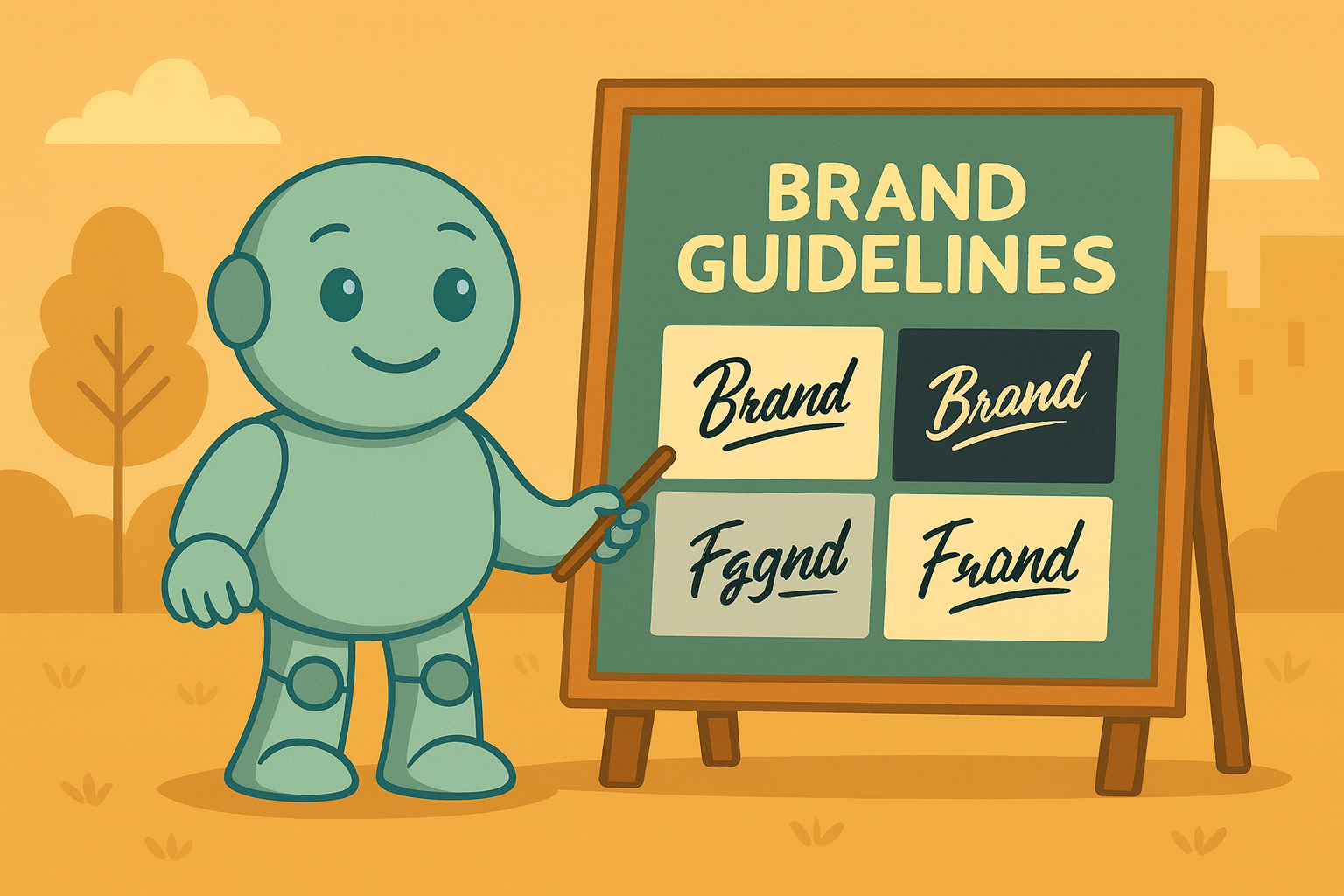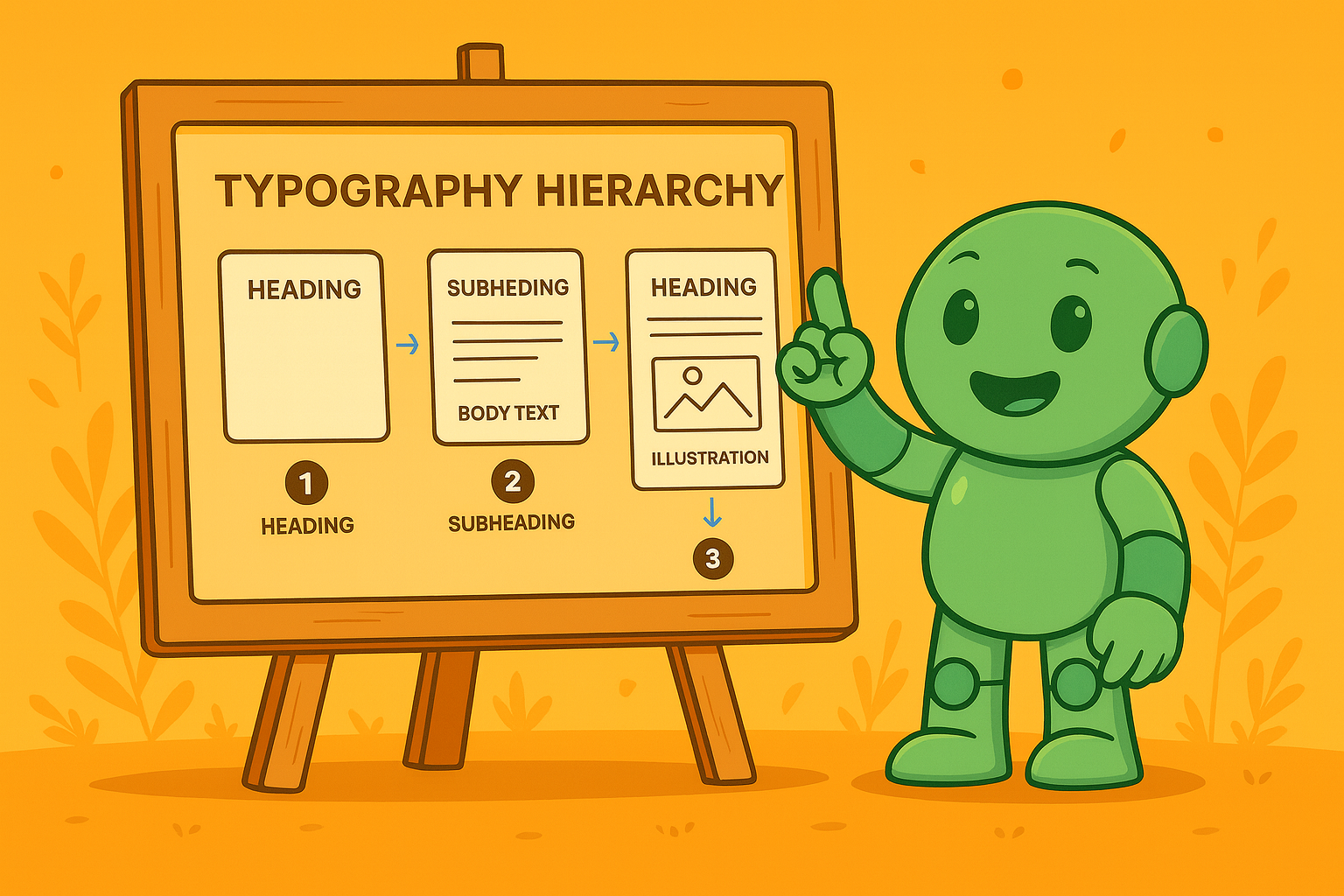How to Create Brand Guidelines That Work
So, you're ready to create your brand guidelines. This is more than just a creative exercise; it's about defining your brand’s very essence, establishing a solid visual system, nailing down your brand voice, and pulling it all together into one accessible rulebook. Think of it as the strategic blueprint that ensures every single thing you do —from a quick social media post to a critical sales deck— works in harmony to build a powerful, instantly recognizable brand.
Building Your Brand’s Foundation

Before you even think about picking a color or a font, you need a mental shift. Your brand guidelines aren't just a design document; they are a core busainess asset. This is the playbook that translates your brand’s identity into a consistent, reliable experience for your audience. Without one, your messaging and visuals will inevitably drift apart, confusing customers and watering down your impact in the market.
The payoff for getting this right is huge and directly tied to growth. After all, brand consistency is a major driver of business success. A remarkable 68% of organizations report that it contributed at least 10% to their revenue growth. Yet, there's a big gap between knowing and doing. Only about 30% of companies have guidelines that are actually used across their entire organization, which points to a massive opportunity for businesses that can nail this down. You can dig into more branding statistics to see just how much consistency matters.
What Goes Into Your Brand Blueprint
When you're ready to learn how to create brand guidelines that your team will actually use, you first need to know what you’re building. This document is the strategic blueprint for your company’s entire public-facing identity. It's what will steer every piece of creative work your team ships, guaranteeing cohesion and, most importantly, building trust with your audience.
So, what are the pillars holding this all up?
- Brand Story and Core: This is your "why." It’s your mission, your vision, and the core values that guide every decision you make. This is the soul of your brand, and it comes first.
- Visual Identity System: This is what everyone sees. It covers everything from logo usage rules and specific color palettes (with HEX, RGB, and CMYK codes) to typography hierarchies and the style of imagery you use.
- Brand Voice and Tone: This is how your brand sounds. It defines your personality—are you witty, authoritative, or warm and supportive? It should also include clear examples of how that voice adapts to different situations.
- Application and Governance: These are the practical, real-world rules. This section shows exactly how to apply the brand elements, like how a logo should look on a t-shirt versus a website. It also clarifies who owns and updates the guidelines.
The biggest mistake I see people make is treating brand guidelines as a one-and-done project. Your guide should be a living document that evolves with your business. It needs to adapt to new marketing channels and shifting customer expectations. Treat it as a tool for empowerment, not a list of restrictions.
To get started, it’s helpful to see all the moving parts in one place. Every great brand guide, no matter how creative, is built on a solid foundation of these core components.
Core Components of Effective Brand Guidelines
| Component | What It Defines | Why It's Critical |
|---|---|---|
| Mission & Vision | Your company's purpose and future aspirations. | Anchors the brand in a meaningful story beyond just products or services. |
| Logo Usage | Rules for logo size, placement, clear space, and incorrect usage. | Protects the brand's primary identifier from being distorted or weakened. |
| Color Palette | Primary, secondary, and tertiary colors with specific color codes. | Creates emotional connection and ensures visual consistency across all media. |
| Typography | Font families, sizes, weights, and hierarchies for headlines and body text. | Ensures readability and establishes a consistent typographic personality. |
| Voice & Tone | The brand's personality and communication style in various contexts. | Builds a relatable and trustworthy relationship with the audience. |
| Imagery Style | Guidelines for photography, illustration, and iconography. | Ensures all visuals feel like they belong to the same cohesive brand family. |
This table isn't just a checklist; it's the recipe for a document that can truly guide your team. By clearly defining each of these elements, you're not just creating rules—you're providing the building blocks for a strong, consistent, and memorable brand.
Defining Your Brand’s Core and Voice
It’s easy to get caught up in the visuals—the logo, the colors, the fonts. Those are the elements people see first. But what truly makes them connect with you, what builds lasting loyalty, is your brand's core. Before you can decide how your brand looks, you have to be crystal clear on who it is. This means getting to the heart of your brand’s story: its purpose, mission, and the values that guide every decision.
These aren't just fluffy buzzwords to fill out an "About Us" page. They are your strategic foundation, your internal compass. This core philosophy will inform everything from product development to the way your support team talks to customers.
To get started, pull your founding team into a room and get ready for some tough, honest conversations. Ask these questions:
- Purpose: Beyond making a profit, why do you exist? What problem are you truly trying to solve for people?
- Mission: What are you actively trying to accomplish? What’s the tangible goal you're working toward every day?
- Values: What are the 3-5 non-negotiable principles that shape your company's culture and behavior?
Let’s imagine a sustainable clothing brand. Their purpose might be "to reduce fashion's environmental impact." The mission, then, becomes "to create beautiful, zero-waste garments." The values supporting this could be transparency, craftsmanship, and community. Getting these answers down on paper gives your brand its soul.
Translating Your Core into a Brand Voice
Once you know who you are, you can decide how you sound. Your brand voice is the distinct personality that comes through in every piece of communication. Are you authoritative and professional? Witty and a bit rebellious? Or maybe warm and supportive? Whatever you choose, it needs to be a direct reflection of your core mission and values.
Now, it's important to distinguish voice from tone. Your brand tone is the emotional inflection of that voice, which naturally adapts to different situations. Think of it this way: your voice is constant; your tone is situational.
A consistent brand voice doesn't mean sounding like a robot. It means having a recognizable personality that knows how to adapt its tone for different contexts, just like a real person would.
Take a software company whose brand voice is "helpful and expert." Here’s how their tone might shift depending on the context:
- Website Copy: Confident and clear, breaking down complex features into simple, easy-to-understand terms.
- Social Media Post: Engaging and a little informal, maybe sharing a quick pro-tip or some interesting industry news.
- Customer Support Email: Empathetic and patient, carefully guiding a frustrated user through a solution.
The underlying personality—the helpful expert—never changes. It's the delivery that shifts to match the audience's needs and the channel's expectations.
Building Trust Through Consistent Communication
This consistency is how you build familiarity and, ultimately, trust. It’s a make-or-break element when learning how to create brand guidelines that actually resonate with people. After all, a staggering 81% of consumers say they need to trust a brand before they'll even consider buying from it.
And in our hyper-connected world, social media plays a huge role. With 77% of consumers preferring to shop with brands they follow on social platforms, a unified voice across all channels isn't just nice to have—it's essential. You can dig deeper into what drives consumer trust in modern brands to see just how critical this is.
This is why documenting your voice and tone in your brand guidelines is so important. Don't just list a few adjectives like "friendly" or "bold" and call it a day. You need to provide concrete examples. Show your team exactly what "friendly" looks like in an email subject line versus how it translates into a tweet. This kind of practical guidance turns abstract ideas into actionable rules, ensuring your brand speaks with a single, authentic voice, no matter where it shows up.
Establishing Your Visual Identity System
Once you've nailed down your brand's core purpose and voice, it's time to give that personality a face. This is where you create the tangible, visual elements people will instantly recognize as yours. A strong visual identity system is what makes your brand look consistent and professional everywhere it shows up, from your website to a physical product.
The logo is your cornerstone. It’s your single most important visual asset, so your guidelines need to be crystal clear to protect it. The goal is to create rules that are so straightforward that anyone—from your internal team to an outside partner—can get it right every time. For a deeper look at how these visual choices fit into the bigger picture, this guide on creating a brand identity offers some great context.
Mastering Your Logo Usage
Your logo guidelines should leave zero room for error. The first rule to set is the clear space requirement—think of it as an invisible protective bubble around your logo where no other text or graphics can intrude. A good rule of thumb is to make this space equal to half the width of the logo itself. This gives it the breathing room it needs to stand out.
Next up is minimum size. Your logo has to stay legible, whether it’s a tiny favicon in a browser tab or printed on a business card. You need to determine the absolute smallest it can be displayed in pixels for digital and in inches or millimeters for print. This simple step prevents your logo from ever becoming a blurry, unreadable smudge.
Finally, you need to show people what not to do. Don't just tell them; show them with clear visual examples of common logo abuse:
- Stretching or squashing its proportions.
- Changing the official brand colors.
- Placing it on a busy or low-contrast background that makes it disappear.
- Adding drop shadows or other unapproved effects.
A well-defined visual system isn't about restriction; it's about empowerment. It gives your team a clear framework to create beautiful, on-brand materials with confidence, knowing they are reinforcing the brand's identity correctly every single time.
Building Your Color Palette
Color is one of the fastest ways to spark an emotional connection and build brand recognition. Your guidelines must define a clear color palette, complete with primary, secondary, and accent colors. For every single color, you need to provide the exact codes to ensure consistency everywhere.
- HEX codes for web design.
- RGB values for digital screens (presentations, videos).
- CMYK values for anything printed.
This technical detail is non-negotiable. It’s what guarantees your brand’s signature blue looks identical on a website, in a PowerPoint, and on a printed brochure.
Demystifying Your Typography
If your brand's voice is what you say, typography is how you say it. A solid typographic hierarchy guides the reader's eye and subtly reinforces your brand's personality. Don't just pick a font you like; you need to build a system.
This infographic breaks down a simple typographic hierarchy, showing how different font sizes and weights create a clear structure for headings, subheadings, and body text.

As you can see, a well-defined system isn't just about looking good; it's about creating a smooth and intuitive reading experience for your audience.
Defining Your Imagery Style
Finally, your visual identity extends to every photo, illustration, and icon you use. What's the vibe? Are your photos bright, airy, and full of natural light? Or are they high-contrast, moody, and dramatic?
Define the mood and style of your imagery. The best way to do this is to provide a "mood board" of on-brand examples and explain why they work. This ensures every visual element feels authentic and part of a cohesive brand family, fully rounding out your visual identity.
Making Your Brand Guidelines Stick: Documentation and Sharing
You’ve poured all this work into crafting a brilliant brand identity. But let's be honest—those guidelines are completely useless if they’re just a PDF collecting digital dust on someone's hard drive. The real magic happens when you turn those rules into a living, breathing part of your team's everyday work. This is the crucial step where documentation becomes activation.
The whole point is to put an end to the brand chaos. No more hunting for the right logo. No more guessing which shade of blue is the correct one. We're aiming for a single source of truth that empowers everyone, from your internal team to your freelance partners, to represent your brand with confidence and consistency.
Build a Centralized Brand Hub
Forget about static files and email attachments. To get everyone on the same page, you need a centralized, digital brand hub. Think of platforms like Frontify or Zeroheight; they allow for real-time updates, clear version control, and easy access for anyone who needs it.
This dynamic approach ensures your most critical components—from precise logo usage rules to specific color codes and typography systems—are always up-to-date. You can find more in-depth strategies for advanced brand guidelines on avintivmedia.com.
A digital hub fundamentally changes how people interact with your brand. It’s no longer a restrictive rulebook but an interactive toolkit. A designer can grab the exact logo file they need on the spot. A marketer can copy the right HEX code for a social media graphic in seconds. A new hire can quickly get a feel for the brand voice without having to ask.
Your brand hub should be built for action, not just reference. Make it the path of least resistance. If finding the correct presentation template is easier than creating a new one from scratch, people will naturally fall in line.
Your Brand Hub Checklist
For your hub to be truly effective, it must be practical. It needs to contain not just the rules, but also the ready-to-use assets that make following those rules easy. Think of it as a one-stop shop for creating anything on-brand.
Here’s a practical checklist of what to pack into your hub:
- Downloadable Logo Files: Include every variation—primary, secondary, icons—in formats ready for web (SVG, PNG) and print (EPS).
- Color Palette Information: Clearly lay out your primary, secondary, and neutral colors. Make sure to provide their HEX, RGB, and CMYK values for easy use.
- Typography Guidelines: Detail the font hierarchy for headlines, subheadings, and body copy. If you use licensed fonts, include links to where your team can get them.
- Brand Voice and Tone Examples: Don’t just tell—show. Provide real-world examples of on-brand copy for emails, social media posts, and website headlines.
- Ready-to-Use Templates: This is a game-changer for adoption. Stock the hub with templates for presentations (PowerPoint, Google Slides), social media graphics (Canva), and even email signatures.
- Governance Rules: Outline who "owns" the brand guidelines, who is in charge of updates, and the process for requesting new assets or giving feedback. This keeps your system organized and allows it to evolve with your brand.
Ensuring Consistent Brand Application
So you’ve poured your heart and soul into defining your brand. You’ve got the core nailed down, the visuals are stunning, and everything is neatly documented. That’s a huge win, but here's the reality: the most beautiful brand guidelines are just a document until people actually start using them.
The real work begins now. Moving from documentation to adoption is where the magic happens. Brand consistency isn't achieved when the guide is finished; it’s achieved when it’s alive and breathing in every corner of your organization. This starts with a smart rollout. Don't just fire off an email with a link and hope for the best. You need to launch your new guidelines with intention, usually through a training session that gets everyone excited and explains the why behind the what. Show your teams how this unified approach actually makes their jobs easier and contributes to the brand everyone is proud to build.
Drive Adoption Through Empowerment
The secret to making consistency stick is to make it the easiest option available. Forget playing brand police. Instead, focus on empowering your team with the tools and knowledge they need to create on-brand work without even thinking about it.
One of my favorite ways to do this is to appoint brand champions in different departments. These are the people who are naturally enthusiastic about the brand. They can become the friendly, go-to resource for their colleagues, offering quick advice and helping keep things on track from the inside out. This approach turns brand consistency into a shared mission, not just another rule from marketing.
Your goal is to make it easier to stay on-brand than to go rogue. When the correct templates, logos, and colors are just a click away, people will naturally use them. Adoption isn't about enforcing rules; it's about removing friction.
Integrate Guidelines into Daily Workflows
To really make your brand standards second nature, you have to build them directly into the tools your team uses every single day. This is all about creating a library of practical, plug-and-play templates that have all the right branding baked in from the start.
Think about what your teams create most often:
- Presentation Decks: Build pre-made templates in PowerPoint or Google Slides. Make sure the logo placement, fonts, and color palettes are already set up perfectly.
- Social Media Graphics: Create a set of versatile Canva templates for different post types. This ensures your feed looks cohesive, no matter who is posting.
- Document Templates: Offer branded letterheads, reports, and even email signatures in Word or Google Docs.
When you provide these kinds of resources, you're not just saving your team time—you're eliminating the guesswork. They get to focus on the actual content, knowing the visual side is already handled and perfectly on-brand.
And as you see your brand grow and gain recognition, remember that protecting its identity is paramount. To learn more about the legal side of things, our complete guide to registering a business name is a great resource for securing your most valuable assets.
Common Questions About Brand Guidelines
Even with a solid plan, a few questions always seem to surface when you're deep in the process of creating brand guidelines. I've been there. Let's walk through some of the most common hurdles to make sure the guide you build is both practical and powerful.
How Often Should We Update Our Brand Guidelines?
Think of your brand guidelines as a living document, not a stone tablet. It needs to breathe and grow with your business. I generally recommend a major review every 2-3 years, but you should also revisit it whenever your company hits a major milestone. This could be a full rebrand, a big new product launch, or a strategic pivot to a new target audience.
That said, don't wait for a major event to make small tweaks. Minor updates should be an ongoing thing. Maybe you add new social media templates each quarter or refresh your approved photography style once a year. If you use a digital brand hub, these little changes are seamless. It stops people from accidentally grabbing old assets and keeps everyone on the same page.
The real value of brand guidelines isn't just in their creation, but in their maintenance. A guide that evolves with your business stays relevant and useful, continuing to serve as the single source of truth for your entire team.
This approach ensures your brand always feels current and responsive, not dated.
What Is the Difference Between a Style Guide and Brand Guidelines?
People often use these terms interchangeably, but there's a crucial difference that gets to the heart of branding itself.
A style guide is the tactical rulebook. It's focused almost entirely on the visual and editorial rules—things like logo usage, your color palette, typography standards, and grammar points. It dictates how the brand should look and sound on a technical level.
Brand guidelines, on the other hand, are much more comprehensive. They contain everything you'd find in a style guide, but they also anchor those rules in your brand's core strategy. This is where you document the why behind the what:
- Mission and Vision: Your reason for being and where you're headed.
- Core Values: The non-negotiable principles that shape your culture and decisions.
- Brand Personality and Voice: The unique character that comes through in all your communications.
- Target Audience: A detailed picture of the people you're trying to connect with.
Here’s a simple way to think about it: a style guide gives you the rules. Brand guidelines give you the rules and the reason.
Can a Small Business Create Guidelines Without a Big Budget?
Absolutely. You don't need a massive budget to create effective brand guidelines. It’s about clarity and consistency, not cash. I've seen startups build incredibly effective guides using a simple Google Doc or a basic slide deck. The magic is in the intentionality.
Don't get overwhelmed. Just start by defining the absolute essentials:
- Primary Logo Usage: Show your main logo and define its clear space rules.
- Core Color Palette: Lock in 2-3 primary colors and list their HEX codes.
- Basic Typography: Pick one font for headlines and another for body text.
- Brand Voice Summary: A few paragraphs describing your brand’s personality is all you need.
Getting these fundamentals down early is a smart investment. It prevents the kind of inconsistent, messy branding that becomes a nightmare—and a much bigger expense—to untangle down the road. In fact, figuring out if your company needs a naming strategy is a fantastic first step that informs this whole process.
How Do I Get My Whole Team to Actually Use the Guidelines?
Getting your team to adopt the guidelines boils down to two things: making it incredibly easy and clearly explaining the "why."
First, don't just send out a mass email and hope for the best. Launch your new guidelines with an engaging training session. Show your teams—from marketing to sales to HR—how brand consistency makes their own work more effective and strengthens the company they're all helping to build.
Second, build the guidelines directly into their daily workflows. Create pre-made templates in tools they already use, like Canva, Google Docs, or PowerPoint, with the correct fonts, colors, and logos already baked in. When following the guide is the path of least resistance, adoption feels natural, not forced.
Ready to build a powerful brand from the ground up? Start with the perfect name. At NameRobot, we provide a full suite of tools, from smart name generators to in-depth analysis, to help you find a name that’s not just catchy but market-ready. Explore NameRobot today!















